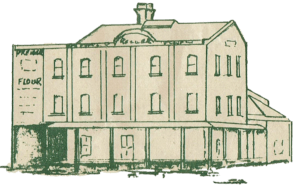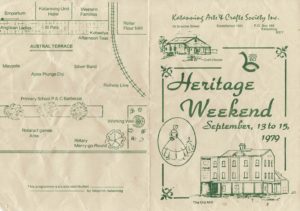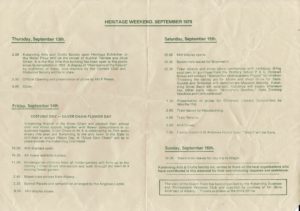Katanning Landmark. Katanning Landmark. Katanning Landmark. Katanning Landmark. Katanning Landmark. Katanning Landmark. Katanning Landmark. Katanning Landmark.
Katanning’s landmark will live again.
By Sharon Peacock
Great Southern Herald – 25 May 1983

Three years ago a handful of people were fighting to save what they called a Katanning landmark. It was in danger of being sold and possibly demolished or re-modernised beyond any recognition. The handful of people had other ideas. They wanted to restore the landmark to its original condition and use it as a museum.
The landmark, of course, was the old flour mill on the corner of Austral Terrace and Clive Street. In 1980 it had stood empty for eight years, an easy prey for for vandals and decay. But in its heyday, the Katanning Roller Flour Mill was the centre around which Katanning business life buzzed. It was built between 1889 and 1891 by the two Piesse brothers, Frederick and Charles.
It was the first inland flour mill in WA and its construction went hand in hand with the establishment of Katanning. The bricks for the mill were hand made in a clay area south of Katanning and the mill itself was built using only hand tools. The milling machines were imported either from England or Germany and were all steam driven.
Most of the flour produced at the mill was sent overseas, mainly to Singapore and Egypt. At one stage the mill was the main electricity supplier in Katanning and employed about 300 people. When Frederick Piesse died in 1912, the mill almost closed down. However, a group of Katanning businessmen decided that would be a severe blow to the town and formed a company to take over the business.
The new concern began to operate on June 14, 1927, as the Katanning Flour Mills Ltd. The mill continued to operate under this arrangement until 1969 and, in 1970, became known as the Katanning Oat Milling Company. The original mill was closed down in 1972 when the new OMC silos opened on the Great Southern Highway. It remained closed to all except vandals and pests until 1979 when the Katanning Arts and Crafts Society staged an exhibition in the mill.
Imaginations
The exhibition sparked imaginations around the town and when it was heard that the mill would probably be put up for sale on the open market, a group of people made a concerted effort to persuade the Katanning Shire Council to buy the mill. The mill’s directors supported this idea and offered the mill to the council for the much reduced price of $35,000. On the open market it probably could have been sold for as much as $70,000 but the directors wanted the building to stay standing and as much as its original condition as possible. Concerted effort paid off in July, 1981 when the council’s offer of $29,000 for the mill was accepted by the directors.
Almost one year before, the National Trust had included the mill in its records, classifying it as an historical building. “The former mill is historically important not only for its influence on the development of Katanning but also for the success of its products in overcoming prejudice against Western Australian flour,” said a report in the Trust’s magazine.
“Architecturally it is one of a group of mills of similar type which were scattered through the wheatbelt but which have become rare and, from the point of view of industrial archeology, the survival of so much of the machinery is of great importance. The vertical form, reflecting gravity conveyance in the milling process is now made obsolete by pneumatic conveying techniques and is therefor of historical significance.”
Shortly after the council purchased the mill and the intention to turn it into a museum was announced, the National Trust offerred a dollar for dollar grant of $22,000 to aid the restoration. The terms of the grant were that it was to be paid over three years, with $3,000 being raised and given in the first year, $7,000 in the second, and $11,000 in the third. That third year is 1984 and the mill museum restoration committee is well on its way toward the $11,000 figure. In fact, the committee has so far had no problems raising its $22,000 to match the National Trust’s contribution. But since the mill was bought and the restoration committee formed, little has been heard of the mill.
What has been going on since 1981?
According to a committee member very little can be seen from the outside, but inside it has been quite a hive of activity.
The committee consists of shire councillors Eric McFarland and Keith Webster, historical society representative Ann Hepworth, educational representative Norma Blyth, WA Museums Association representative Ainslie Evans, and John Appleby and John McNally. Their aim is to have the mill cleaned up and restored to something of its original condition by Katanning’s centenary year 1989.
By then it will house all the historical artifacts currently in the Katanning Historical Museum. Not only will the mill provide room for all the items to be exhibited where they can be seen by everyone, but the mill museum will also be officially recognised by the WA Museums Association. The current museum is not.
Exceed
The cost of restoration is going to greatly exceed the $44,000 which the mill committee and the National Trust have raised between them, according to committee members. But they aren’t worried. They have developed an unusual fund raising method which they hope will continue long after the restoration is complete and the mill museum is open to the public.
That method, of course, is the visits to Katanning by groups of American sailors. The first group of 65 sailors and marines visited in August 1981. They were each charged $100 for a weekend in Katanning, staying with billets and being entertained with tours to local points of interest, dances, social nights, and barbecues. Since then, three more visits have been arranged, some more financially successful than others but all a success in terms of enjoyment and public relations.
Several sailors visiting Katanning on recent trips have said they did so because they heard what a great time their friends had. One even returned for a second visit. Word is spreading and committee members say the tours are likely to continue as long as American ships visit WA ports.
Restoration
Restoration work on the mill began with the windows. They have been completely re-glazed and the frames rebuilt by a professional glazier. The mill’s brickwork has been repaired and a new roof costing $8,000 was recently fitted. The building has also been made vandal proof.
Tenders have recently been called for the exterior painting of the mill and interior electrical wiring. Once those jobs are completed, the next major projects will be cleaning and possibly fumigating. Dust and flour are two major things that have to be shifted before museum articles can be moved in. The committee is purchasing a heavy duty vacuum cleaner to help with the cleaning.

Program for the official opening of the mill to the general public.

Thanks to Ainslie Evans for providing this information.
Return to HOME Page
Visit the PREMIER MILL HOTEL Facebook Page
Visit the PREMIER MILL HOTEL Website
